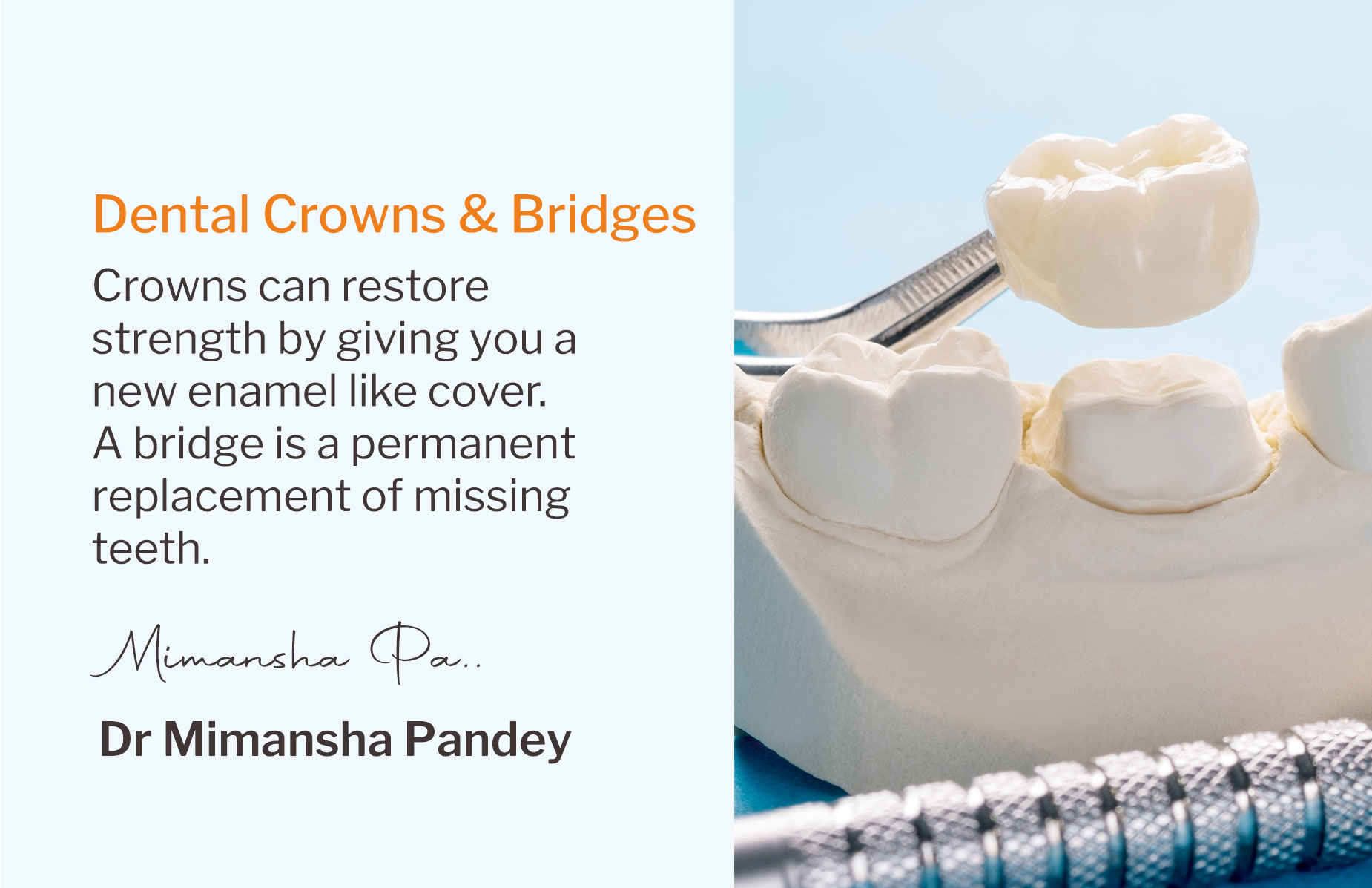Trauma, decay or root canal treatment may severely weaken a tooth. A crown is often required to save a tooth and to strengthen it. A crown will fit over the existing tooth and replaces the crown ie. the part of the tooth you can see above your gums.
Crowns are usually made of either porcelain or porcelain fused to gold and are made to match the colour of your natural teeth. Crowns may also be made of Gold.
Missing teeth can be replaced by using your natural teeth to anchor a bridge with artificial teeth suspended in the gap. When a tooth is lost through trauma or cannot be saved by root canal treatment, a bridge is one of the possible solutions as are permanent dental implants.
What are Crowns and Bridges?
The crown is a cap that is placed over a single tooth to protect it from further damage and improve its overall aesthetics. It is usually recommended for cases where the use of conservative fillings is unable to restore the tooth’s form or function.
The bridge is used to replace one or more missing teeth. Some bridges consist of crowns affixed to neighbouring teeth – one on each side of the missing tooth – that are used to hold a replacement tooth in position. Another type of bridge is anchored onto adjacent tooth using wing-like attachments. The only type of bridge that does not rely on – and wear down – neighbouring teeth is the implant-supported bridge, which is held firmly in position by strategically placed dental implants.
Crowns and bridges are usually made from gold, porcelain, metal or a combination of these materials. Modern day crowns and bridges wholly made from tooth-coloured material are increasingly popular due to greater awareness and their lifelike aesthetics. Advances in dental technology have made these prosthetic teeth appear so realistic that it is practically impossible to tell them apart from natural teeth.
What are Crowns and Bridges used for?
Dental crowns and bridges are developed to restore the look and function to badly damaged or missing teeth. Crown and bridge restorations provide you a durable and aesthetic solution for a natural looking and beautiful smile.
The crown is used to protect and strengthen the tooth that has been weakened by a decay or injury. Bridges are designed to prevent the upper and lower teeth located around the missing teeth from moving so as to improve the overall functional and aesthetic qualities.
Bridges also provide a permanent, non-removable teeth replacement alternative to removable partial dentures that have been criticised for being unstable and troublesome to maintain.
By replacing your missing tooth or teeth with crowns and bridges, you will be able to chew your food properly and restore your smile.
What is the procedure for Crowns and Bridges like?
Crown procedure: A typical crown restoration takes two visits. On the initial visit, X-rays will be taken to assess the roots and surrounding bone to make sure your tooth has the sufficient bone quantity and quality to support the restoration.
A mould will be taken of the tooth that is being crowned and surrounding teeth in the opposing jaw – the latter is to make sure that the crown will not affect your bite. A temporary crown will be placed to protect the tooth and restore its appearance while awaiting the manufacturing of the permanent crown at the dental lab.
The mould or dental impression is sent to the dental laboratory to serve as a blueprint for fabrication. Based on information provided by the dental impression, the lab technician will create the crown to a specific shape and structure that will fit exactly into position over the existing tooth.
On the next visit, the dentist will remove your temporary crown and place the permanent crown into position to check for fit and colour. Once he is satisfied with the form and aesthetics of the new crown, the dentist would cement the permanent crown into position.
Bridge procedure: The process of getting a dental bridge is, in some ways, similar to that of a crown. It also involves taking an impression of the teeth to be used as a model from which the prosthetic teeth (in this case, the bridge, pontic and crowns) will be fabricated by the dental lab.
The difference lies in the preparation of the abutment tooth. An abutment tooth refers to the natural tooth that is being selected to support the prosthesis. As a bridge may be designed to replace one or more missing teeth, the number of abutment teeth that need to be prepared varies. Preparation involves filing down the selected teeth to allow adequate room for the crown to be placed over them.
Similar to the crowning process, a temporary bridge is placed over the abutment teeth while the artificial teeth are being prepared and fabricated at a dental lab. To ensure a perfect fit for the bridge framework, further adjustments and trial placements of the prosthesis – along with multiple visits – may be necessary. When everything checks out, the bridge is then cemented into place. The entire process may take a few weeks.
When do I need a Crown?
A dental crown is a tooth-shaped cap that covers the tooth above the gum line. It may be used independently as a single tooth restoration or as part of a dental bridge. The purpose of a crown is to reinforce the strength of a tooth and to improve its appearance.
A dental crown is usually recommended to solve the following dental situations:
- Repair fractured or severely worn out tooth
- Replace decayed or fractured tooth that does not have enough sound tooth left to support a normal filling.
- Correct discoloured or misshapen tooth that lacks the structural integrity for a veneer or cosmetic filling
- Prosthetic tooth for an implant
- Help anchor a dental bridge
